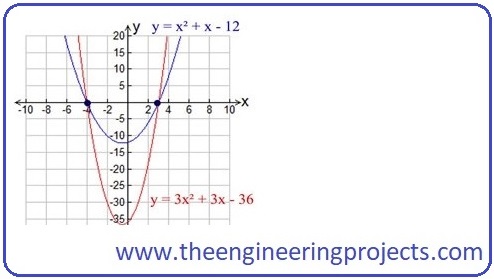
- Introduction to Quadratic Equations.
- Solutions of a Quadratic Equation.
- Graphical Representation of Quadratic Equations.
- Methods to solve Quadratic Equation.
- Multiple Graphical Solutions of Quadratic Equations.
- Forms of Quadratic Equations.
- Comparison between quadratic equations.
Introduction to Quadratic Equations
When we talk about numbers , it is quite obvious to think about their combination, which are actually polynomials having different degrees. You may think why we are discussing polynomials here while we are interested in quadratic equations, you’ll get this quadratic equation from polynomials actually. Since to make some combination we need some constants and variables, so for some constant a and some variable ‘x’, we can write ‘ax’ which is a product of constant a and variable ‘x’. Now if we add one more constant by writing in a way such that ‘ax+b’, so this is a polynomial of degree 1 , because here power of ‘x’ is 1 and we can call it a linear equation. Similarly a second degree polynomial will be ‘ax2+bx+c’ with a,b,c constants and you may consider these constants are real numbers. Generally a polynomial of degree n can be written as below:a0+a1x+a2x2+ . . . +anxn
where all a0, a1, a2, . . . ,an are constants which belong to the set of real numbers. Here we will just talk about 2nd degree polynomial. A 2nd degree polynomial of the form ‘ax2+bx+c’ is called a quadratic polynomial and by equating equal to 0 we get a quadratic equation, which is:
ax2+bx+c=0 where a,b & c are constants and real numbers.
Here a is not equal to 0, otherwise it will be a linear equation.
Hitory of Quadratic Equations
After studying simple linear equations, mathematicians put their minds towards 2nd degree equations. The Egyptian Mathematician, Berlin Papyrus, gave the idea of a two-term quadratic equation. After that, Chinese mathematicians used geometric methods to solve quadratic equations with positive roots, by defining on the real line.Possible Solutions of a Quadratic Equation
As in the quadratic equation, we have highest degree 2 of a term , known as quadratic term and shows that this equation may have at most two solutions. These two solutions of a quadratic polynomial are called zeros or positive roots of the equation. Some times we can find both solutions easily but some times it is hard to find exactly 2 solutions and in that case root does not lie on the real line. We may get 0, 1 or 2 solutions of a quadratic equation.Solutions of a quadratic equation
In general, there are only 2 solutions exist for a quadratic equation because it is a 2nd degree polynomial and are named as positive roots.Graphical Representation of Quadratic Equation
Yes! You can analyze Quadratic Equations graphically. Quadratic equations represent a parabola, if it meets at some points on the real line then those points are roots of the equation, otherwise it has no solution. Here the following figure is showing a graph of quadratic equation.
How to Solve Quadratic Equations ?
Now, let's have a look at How to solve quadratic equations and get its roots (if exist). There are different methods to solve these quadratic equations and here I am going to discus three of them, which are most commonly used.1. Quadratic Formula
- We can find solutions/roots of a quadratic equation by using simple a well known formula which is known as quadratic formula and is given below:

2. Method of Factorization
- Secondly, we can solve quadratic equation by another method which is known as method of Factorization. This method is more clear from the following figure which shows step by step procedure to apply on some quadratic equation.

3. Method of Completing Square
- We can find roots of a quadratic equation by using method of Completing Suqare.

Comparison between Quadratic Equations
Suppose you have 2 different quadratic equations x2+x+-12=0 and the other equation 3x2+3x+-36=0 and you want to compare these equations. To check we must have to focus on their roots and graphical representation , let’s solve this equation by using method of factorization.3x2+3x+-36=0 , x2+x+-12=0
3(x2+x+-12)=0 , x2+4x-3x+-12=0
x2+x+-12=0 , x (x+4) – 3 (x+4) =0
(x-3) (x+4)=0 and this shows x=3 and x=-4.
From both above equations, we see that both equations have same roots but we cannot say these both equations are exactly equal, because we are not sure about all those points of the parabola other than roots. But by drawing parabolas of these equations we can judge easily and the following figure is showing these parabolas have only those common points which are their roots. So we cannot say these are equal quadratic equations because their behaviour is not same graphically. From here, we can also say that if roots are same for some quadratic equations then it doesn’t mean all those equations will be the same.



